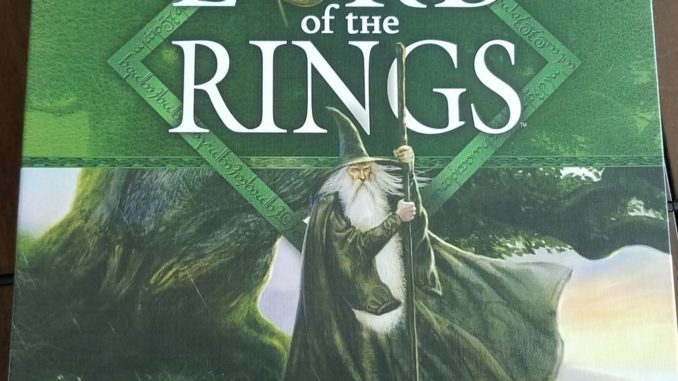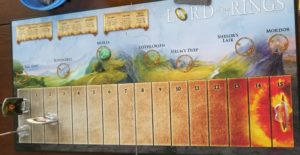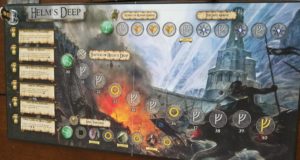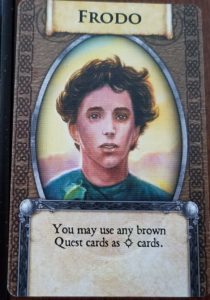
One Ring to rule them all, One Ring to find them, One Ring to bring them all, and in the darkness bind them
Despite being kind of a geek, I didn’t read The Lord of the Rings until college. The movies were about to come out and this cute girl said she really liked the books. So I sat down one summer to read them. While I don’t regret doing it, I’ve never had an inclination to go back and read them again. But now that same cute girl has been playing the online game with our son and he began to ask questions about the story. Neither of us wanted to read it again, but fortunately, there are three very fine movies. This, in turn, led into digging through our game closet and finding several Lord of the Rings themed games. One of which was a cooperative game called, simply, The Lord of the Rings. We had played this at a friends house. I remembered liking it and then a few years later I picked it up for us. How does it hold up?
Gameplay- C

To win the game you have to take the One Ring to Mount Doom and destroy it. The game plays out over the course of the books, moving along a story track. Some of stops are friendly rest areas, like Rivendell and Lothlorian, where you can pick up new cards. The others lead to encounter boards where you have to face off against Sauron’s forces. There are four boards, Moria, Helm’s Deep, Shelob’s Lair and Mordor.
Your characters, all hobbits, are set on the Corruption track. As the game progresses, they can gain corruption and move closer to the Eye of Sauron. Sauron can also move closer to the hobbits. If a hobbit is on the same space as the Eye, they become an agent of Sauron and are out of the game. If the Ring Bearer gets to the same space, the game is over.

On your turn, you draw an event tile from the stack. These tiles have different icons on them that trigger different actions. Some tiles are helpful and will move your hobbits along the path to Mordor. But many are rather quite unpleasant. Every time you draw one of the unpleasant tiles, you then get the honor of drawing another tile. This continues until you’ve drawn a helpful tile.
There are two ways to complete a game board; move along the path track or finish the event track. The event track is the vertical one on the left side of the board. You move along this when you draw certain event tiles. The event track signifies events from the books. A few are helpful to the party. Most are not. If you reach the bottom of the track, you’ve completed that board regardless of where you are on the path.
The other way to complete a board, and the way you’re aiming for, is to move along the path, which is the center set of circles. To move, you must play a card with symbols matching the paths track. Each player can play two cards on their turn; one brown and one grey. When you advance the party token along the track, you acquire whatever is in the circle. Sometimes these are new cards, sometimes there are helpful tokens and sometimes you have to roll a die. This die has multiple unpleasant sides that may corrupt your hobbit, make you discard cards or even more Sauron closer to your party.
Because of the way the tiles work, it’s possible to move down the event track without anyone getting a turn. This can be really bad as you miss the chance to acquire resources and lots of bad things have happened. But also, when you complete a board your hobbits gain corruption based on their lack of three tokens: heart, star and ring. These are spread out across the different path tracks along the board. If a hobbit doesn’t get one of each, then you’ll corrupt at the end. Also of note, the game can have up to five players and there are only three of most tokens on a board. This means if you play with more than three players someone’s getting corrupted.
Production- B+
The game features several dual-sided boards which are all sturdy. There’s no complaint about the durability of the cards or boards.
Theme- B+
 The game does capture the feel of creeping closer and closer to the all-seeing eye. You have to make a lot of tough choices about what resources to spend to make progress. I do like the corruption track as a concept.
The game does capture the feel of creeping closer and closer to the all-seeing eye. You have to make a lot of tough choices about what resources to spend to make progress. I do like the corruption track as a concept.
Despite first coming out around the same time as the movies, the game’s art takes nothing from them. Each character has unique art. This is kind of refreshing despite the movies having cemented how Middle Earth looks in my mind.
One odd part of the game is that all your characters are hobbits. The game was designed for up to five players. If you recall the Lord of the Rings there’s Frodo, Sam, Merry and Pippin. That’s four. So who’s the fifth hobbit you ask? Bilbo perhaps, you suggest hesitantly. But you would be wrong. The fifth hobbit is named Fattie. Yep, that’s right, you can play as everyone’s favorite hobbit no one has heard of.
Expansions- TBD
There are no expansions for this game.
Conclusion- C
The game just feels like punishment. Whether you win or lose comes down in a large part to luck. Do you rocket down the event track quickly all in one go? Did you just have to discard a ton of cards and now can’t do anything? Do you have a ton of cards but this game board happens to not feature that type?
This all combines to a fairly frustrating experience. We have won the game before so it is not impossible. But we’ve also almost lost the game in Moria, the first board because of rotten luck on tile draws. You have choices to make, but they are more about choosing your pain than devising a strategy.
Wayne Basta
Latest posts by Wayne Basta (see all)
- X-Wing Tier List – Rebels - May 10, 2023
